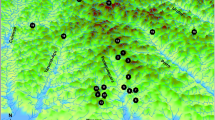Abstract
The yarkand hareLepus yarkandensis Günther, 1875 is one of the endemic mammals in China. We used mitochondrial control region (D-loop) sequences to investigate the genetic variation, population structure and phylogeography of the Yarkand hare from Xinjiang Uighur Autonomous Region. The Yarkand hare holds a high level of haplotype diversity in most populations. In contrast, we found a relatively low level of gene diversity in Niya and Shule populations. The pairwise mismatch distribution suggested a pattern of population expansion. Fu’s test of neutrality was significant for the total population (F s=−10.458), which also suggested a recent population expansion. The pattern of diversification among populations was not consistent with its geographic distributions. Significant divergence was found among some populations, however, no significant divergence among other populations. The results indicate some degree of dispersal of individuals may exist among populations in recent history. Due to past isolation and habitat fragmentation, genetic variation was reduced within populations and division among populations increased. In order to conserve genetic diversity of the Yarkand hare in isolated populations, in the future, it may be advisable to translocate individuals between isolated populations to maintain current levels of genetic variation.
Similar content being viewed by others
References
Altizer S., Harvell D. and Friedle E. 2003. Rapid evolutionary dynamics and disease threats to biodiversity. Trends in Ecology and Evolution 18: 589–596.
Bandelt H. J., Forster P. and Röhl A. 1999. Median-joining networks for inferring intraspecific phylogenies. Molecular Biology and Evolution 16: 37–48.
Excoffier L., Smouse P. E. and Quattro J. M. 1992. Analysis of molecular variance inferred from metric distances among DNA haplotypes: Application to human mitochondrial DNA restriction data. Genetics 131: 479–491.
Fu Y. X. 1997. Statistical tests of neutrality of mutations against population growth, hitchhiking and background selection. Genetics 147: 915–925.
Gao Y. T. 1983. Current studies on the Chinese Yarkand hare. Acta Zoologica Fennica 174: 23–25.
Hedrick P. W. 1996. Molecular Genetic Approaches in Consevation, Oxford University Press, New York: 459–477.
Kocher T. D., Thomas W. K., Meyer A., Edwards S. V., Pääbo S., Villablanca F. X. and Wilson A. C. 1989. Dynamics of mitochodrial DNA evolution in animals: amplification and sequencing with conserved primers. Proceedings of the National Academy of Sciences 86: 6196–6200.
Kumar S., Tamura K., Jakobsen I. B. and Nei M. 2001. MEGA 2: molecular evolutionary genetic analysis software Arizona State University, Tempe, Ariz.
Lacy R. C. 1997. Importance of genetic variation to the viability of mammalian populations. Journal of Mammalogy 78: 320–335.
Madsen T., Shine R., Olsson M. and Wittseil H. 1999. Restoration of an inbred adder population. Nature 402: 34–35.
Meyer A., Kocher T. D., Basasiwaki P. and Wilson A. C. 1990. Monophyletic origin of Lake Victoria cichlid fishes suggested by mitochondrial DNA sequences. Nature 347: 550–553.
Nei M., Maruyama T. and Chakaborty R. 1975. The bottleneck effect and genetic variability in populations. Evolution 29: 1–10.
Nyakaana S. and Arctander P. 1999. Population genetic structure of the African elephant in Uganda based on variation at mitochondrial and nuclear loci: evidence for male-biased gene flow. Molecuar Ecology 8: 1105–1115.
Rogers A. R. and Harpending H. C. 1992. Population growthmakes waves in the distribution of pairwise genetic differences. Molecular Biology and Evolution 9: 552–569.
Rozas J. and Rozas R. 1999. DnaSP version 3: an integrated program for molecular population genetics and molecular evolution analysis. Bioinformatics 15: 174–175.
Sambrook J., Fritsch E. F. and Maniatis T. 1989. Molecular cloning: A Laboratory Manual. 2nd ed. [Chinese edition]. Cold Spring Harbor Laboratory Press, New York: 336–337.
Schneider S., Roessli D. and Excoffier L. 2000. Arlequin: A software for population genetic data analysis. User manual version 2.000. Genetics and Biometry Laboratory, Department of Anthropology, University of Geneva, Switzerland.
Slatkin M. and Hudson R. R. 1991. Pairwise comparisons of mitochondrial DNA sequences in stable and exponential growing populations. Genetics 129: 555–562.
Swofford D. L. 2002. PAUP*: phylogenetic analysis using parsimony (*and other methods). Version 4.0bl0 end. Inc., Sunderland, Massachusetts: Sinauer Associates.
Thompson J. D., Gibson T. J., Plewniak F., Jeanmougin F. and Higgins D. G. 1997. The ClustalX windows interface: flexible strategies for multiple sequence alignment aided by quality analysis tools. Nucleic Acids Research 24: 4876–4882.
Wang S. 1998. China red data book of endangered animals. Science Press, Beijing, China: 413–414.
Wright S. 1951. The genetic structure of populations. Annals of Eugenics 15: 323–354.
Zenger K. R., Richardson B. J. and Vachot-Griffi A. M. 2003. A rapid population expansion retains genetic diversity within European rabbits in Australia. Molecular Ecology 12: 789–794.
Author information
Authors and Affiliations
Corresponding author
Additional information
Associate Editor was Magdalena Niedziałkowska.
Rights and permissions
About this article
Cite this article
Li, Z., Xia, L., Li, Y. et al. Mitochondrial DNA variation and population structure of the yarkand hareLepus yarkandensis . Acta Theriol 51, 243–253 (2006). https://doi.org/10.1007/BF03192676
Received:
Accepted:
Issue Date:
DOI: https://doi.org/10.1007/BF03192676




